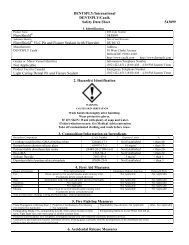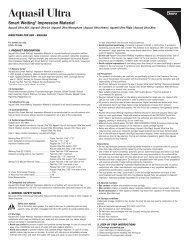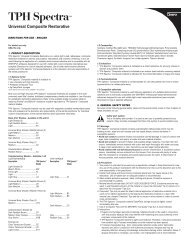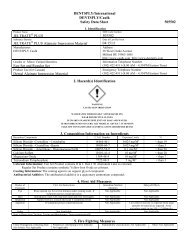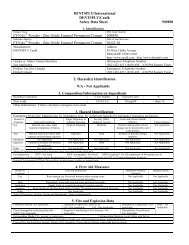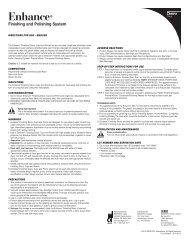Integrity - Caulk
Integrity - Caulk
Integrity - Caulk
You also want an ePaper? Increase the reach of your titles
YUMPU automatically turns print PDFs into web optimized ePapers that Google loves.
is flowing from both mini-Syringe barrels. Disinfect barrels and used mix tip for storage.<br />
Immediately prior to next use, bleed mini-Syringe and install new mix tip as outlined above.<br />
STEP-BY-STEP INSTRUCTIONS<br />
1. Preliminary Impression<br />
1.1 Prior to preparation of the tooth/teeth, evaluate existing contours and anatomy. To<br />
duplicate existing anatomy proceed to primary impression. If contours or anatomy are<br />
deficient, light cured composite may be placed and cured without bonding agent on<br />
the tooth/teeth as a mock up to approximate the desired contours. A missing tooth<br />
may be temporarily replaced with an acrylic denture tooth prior to preliminary<br />
impression.<br />
1.2 Make an alginate or silicone impression of the quadrant including tooth/teeth to be<br />
prepared following manufacturer’s Directions for Use.<br />
1.3 When removed from the mouth, trim the inter dental gingival areas out of the<br />
preliminary impression in the area(s) to be restored to provide bulk for the later<br />
finishing of the <strong>Integrity</strong> ® temporary restoration. In molar areas with absent teeth that<br />
were not replaced prior to impression, the carving in the interproximal areas should<br />
create a ridge for pontic contact between the prepared teeth. NOTE: Store alginate<br />
impressions at 100% humidity until <strong>Integrity</strong> ® material is to be inserted. Technique<br />
Tip: Alternatively, a vacuum-formed matrix may be constructed on a cast (with<br />
diagnostic wax-up, contour modification as indicated).<br />
2. Prepare tooth/teeth<br />
2.1 If pre-impression mock up composite was placed, it should be removed. Prepare<br />
tooth/teeth, and build up as needed following manufacturer’s Directions for Use.<br />
Ensure adequate reduction for material thickness, especially on functional occlusal<br />
surfaces.<br />
2.2 Trial-fit impression (or vacuum-formed matrix) made in Step 2.1 to ensure adequate<br />
orientation. Rinse impression and lightly air dry.<br />
2.3 Block out preparation undercuts with wax or suitable material, clean tooth/teeth<br />
preparation with alcohol soaked gauze and/or air water spray and lightly dry. Do not<br />
desiccate tooth structure. Technique Tip: A thin layer of water-soluble lubricating<br />
medium may be applied to the tooth preparation to facilitate removal of the curing<br />
<strong>Integrity</strong> ® material.<br />
3. Mixing and Application<br />
NOTE: Allow <strong>Integrity</strong> ® Temporary Crown & Bridge Material to reach room temperature<br />
prior to use. Higher temperatures reduce work times and laboratory bench set times<br />
(faster), lower temperatures increase them (slower). Clinically, intraoral set time is<br />
unaffected within the range of allowable storage and initial mixing temperatures.<br />
3.1 Follow instructions for cartridge and dual barrel mini-Syringe loading, bleeding and<br />
mix tip installation. Use only the supplied mixing tips. Mixing tips from other systems<br />
will not fit the <strong>Integrity</strong> ® Temporary Crown & Bridge Material delivery systems.<br />
3.2 Dispense a small amount through the mix tip onto a mixing pad and discard. Without<br />
delay, begin dispensing <strong>Integrity</strong> ® Material directly into the preliminary impression into<br />
the area of the preparation by applying continuous, light pressure to the dispensing<br />
apparatus handle. As the material comes out of the mixing tip, inject it into the<br />
deepest portion of the preliminary impression and then into the gingival areas,<br />
keeping the mixing tip immersed in the material to prevent bubbles. Reseat the<br />
preliminary impression into the patient’s mouth in the proper relative position within 45<br />
seconds of the start of mix.<br />
3.3 Leave impression in place for approximately 2-3 minutes from the start of the mix.<br />
NOTE: The use of lubricant may assist in removal from the mouth.<br />
4. Removal from Mouth<br />
4.1 Remove the impression containing the <strong>Integrity</strong> ® Material restoration during the firm<br />
elastic stage. Monitor the curing process carefully because removal of the temporary<br />
restoration is only possible during the elastic phase. NOTE: Mouth temperature<br />
significantly influences set time. If the material remains on the preparation when the<br />
impression is removed, gently tease the restoration off with gauze. Use finger<br />
pressure only, and dislodge along the path of insertion. Do not rock or torque<br />
restoration off the preparation. Avoid the use of hemostats or other pliers that may<br />
distort the setting <strong>Integrity</strong> ® Material restoration.<br />
4.2 At this elastic phase, gross excess may be quickly trimmed with sharp scissors, being<br />
careful not to distort the restoration or margins.<br />
5. Preparing the Temporary Restoration<br />
5.1 If restoration remains within impression, allow restoration and impression to remain<br />
undisturbed until initial set, approximately 2-3 minutes from start of mix. If restoration<br />
is already out of the impression, place setting restoration in warm water and allow to<br />
set.<br />
5.2 At the completion of set (approximately 6 minutes from start of mix), remove<br />
restoration from impression. Remove the oxygen-inhibited layer with alcohol-soaked<br />
gauze or by the process of finishing and polishing. Remove the excess material and<br />
proximal undercuts with rotary instruments.<br />
5.3 Once curing is complete (7 minutes from start of mix), further refinements and<br />
polishing of the temporary restoration can be made.<br />
5.4 Restoration may be polished with flour of pumice and acrylic polish or by use of<br />
Enhance ® Finishing System and PoGo ® Polishing System or Prisma ® •Gloss Composite<br />
Polishing Paste System. (See complete Directions for Use supplied with polishing<br />
product chosen)<br />
6. Luting the Temporary Restoration<br />
6.1 Check the fit and esthetics of the <strong>Integrity</strong> ® Temporary Crown & Bridge Material<br />
provisional restoration. If additions are necessary, see Step 7, Repairing/Modifying the<br />
Temporary Restoration. If increased retention is desired, microetching (sandblasting)<br />
with 50µ alumina the internal surfaces of the restoration is recommended. The internal<br />
surface of the restoration should be clean and dry prior to cementation.<br />
6.2 <strong>Integrity</strong> ® Temporary Crown & Bridge Material temporary restorations can be<br />
cemented with most commonly used temporary luting agents. See manufacturer’s<br />
complete Directions for Use for compatibility and specific technique. Most eugenolcontaining<br />
temporary cements are compatible with <strong>Integrity</strong> ® Material. However, they<br />
can have a deleterious influence on resin-containing luting systems chosen for final<br />
restoration cementation.<br />
7. Repairing the Temporary Restoration<br />
7.1 Freshly made restorations: Freshly made <strong>Integrity</strong> ® temporary restorations are<br />
compatible with many visible light cured composite restorative materials. For<br />
adjustment of margin discrepancies, roughen the area, extending slightly beyond the<br />
margin onto restoration surface. Apply a compatible flowable composite and light<br />
cure as outlined in the complete Directions for Use. For surface contour and/or<br />
esthetic adjustment, cut back area to be modified with a coarse diamond. Apply and<br />
cure desired shade(s) of characterization material as outlined in the complete<br />
Directions for Use. Adhesive/Bonding agent application is not necessary for<br />
modifications to freshly made <strong>Integrity</strong> ® temporary restorations. Finish, polish and<br />
cement as outlined above.<br />
7.2 Restorations in service: <strong>Integrity</strong> ® temporary restorations are characterized by<br />
excellent mechanical properties. However, should breakage occur, the following<br />
procedures are recommended.<br />
Roughen the surfaces of the breakpoint with a coarse diamond bur and place<br />
undercuts in the adjacent areas. Prepared parts may be placed intraorally to assure fit<br />
and proper alignment. If fractured sections do not approximate, consideration should<br />
be given to remaking, rather than repairing the restoration.<br />
Use freshly mixed <strong>Integrity</strong> ® Material to connect the parts. Hold in place for 1 minute<br />
and allow to fully cure for a minimum of 7 minutes. Remove and finish and polish as<br />
outlined above.<br />
Technique Tips to avoid breakage:<br />
• Be sure adequate preparation reduction/occlusal clearance exists<br />
• Adjust occlusion removing undesirable contacts<br />
• Allow adequate bulk for connectors in multiple unit provisional restorations<br />
• Avoid squeezing the <strong>Integrity</strong> ® Material restoration with pliers when removing restoration<br />
• <strong>Integrity</strong> ® Temporary Crown & Bridge Material restorations are durable under usual<br />
provisional conditions. Many factors contribute to the longevity, thus no definitive<br />
lifespan can be stated. However, if final restorations are not planned to follow in<br />
timely succession, consideration must be given to subsequent removal and<br />
restoration remake.<br />
HYGIENE<br />
Cross-contamination<br />
• Do not reuse single use products. Dispose in accordance with local regulations.<br />
• Reprocess reusable products as described below.<br />
CLEANING<br />
The cartridge/mini-Syringe may be cleaned using a disposable towel soaked with hot water<br />
and soap or detergent. Excess material may be removed with an alcohol-moistened gauze.<br />
DISINFECTION<br />
Dispensers, cartridges, mini-Syringe and used tips left in place on cartridge/mini-Syringe for<br />
storage, if exposed spatter or spray of body fluids or that may have been touched by<br />
contaminated hands, or oral tissues, should be disinfected with a hospital-level disinfectant.<br />
Acceptable disinfectants are EPA-registered as tuberculocidal. Iodophors, sodium<br />
hypochlorite (5.25%), chlorine dioxide and dual or synergized quaternaries are approved<br />
disinfectants. Disinfect by spraying with any recommended hospital-level surface disinfectant<br />
for the contact time recommended by the disinfectant manufacturer for optimum results.<br />
Spraying with glutaraldehyde is not recommended. Some phenolic-based agents and<br />
iodophor-based products may cause surface staining. Agents containing organic solvents,<br />
such as alcohol, may tend to dissolve the plastic. The disinfectant manufacturer’s directions<br />
should be followed properly for optimum results. Water-based disinfectant solutions are<br />
preferred.<br />
Note: Wipe cartridge/mini-Syringe GENTLY, vigorous wiping may destroy the label.<br />
LOT NUMBER AND EXPIRATION DATE<br />
1. Do not use after expiration date. ISO standard uses: “YYYY/MM.”<br />
2. The following numbers should be quoted in all correspondences:<br />
• Reorder number<br />
• Lot number on package<br />
• Expiration date<br />
©2012 DENTSPLY International. All rights reserved.<br />
Manufactured by:<br />
DENTSPLY <strong>Caulk</strong><br />
38 West Clarke Ave.<br />
Milford, DE 19963<br />
Tel.: 1-302-422-4511<br />
Distributed by:<br />
DENTSPLY Canada<br />
161 Vinyl Court<br />
Woodbridge, Ontario<br />
L4L 4A3 Canada<br />
DENTSPLY DETREY GmbH<br />
De-Trey-Str.1<br />
78467 Konstanz<br />
Germany<br />
Tel.: 49-7531-583-0<br />
Form #566399 (R 11/18/12)



